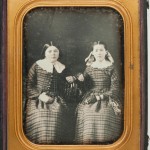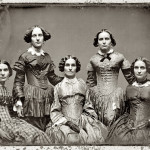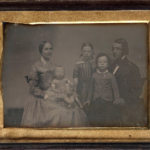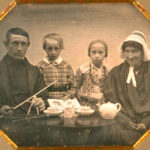Family Group by William Langenheim (1807-1874) & Frederick Langenheim (1812-1879), 1840s
Half-plate daguerreotype, in the original green leather case, ‘W. & F. Langenheim, Philadelphia, Exchange’ embossed in the velvet lining, 1840s. This daguerreotype is the original for two half-plate copy daguerreotypes in institutional collections: at The Metropolitan Museum of Art, and the Library of Congress. The former is reproduced in John Wood’s The Daguerreotype: A Sesquicentennial Celebration (University of Iowa Press, 1989, pl. 91). The small scuff visible in the upper edge of the daguerreotype offered here is replicated photographically in the laterally-reversed copy plates, confirming that the present daguerreotype is the original. The Library of Congress identifies the subjects of its daguerreotype as members of the Cresson and Pritchett families..This exceptional family portrait by two of the earliest practitioners of the daguerreian art in America is remarkable for its large, half-plate size, as well as for its masterful rendering of light. Born in Germany, the Langenheim brothers came to America in the 1830s. They began making daguerreotypes in 1840. They were located at the Exchange address that appears on the case lining of the daguerreotype offered here beginning in 1843, and remained in business at a sequence of addresses on Exchange through 1850. Photographic innovators, the Langenheims were the first to make photographic transparencies on glass. They were also among the first photographers in this country to use Talbot’s positive/negative paper process.
Via: Sotheby’s





